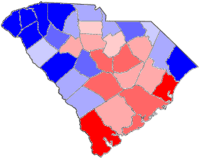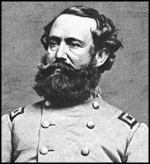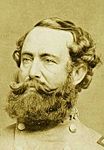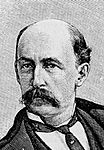1876 South Carolina gubernatorial election facts for kids
|
|||||||||||||||||
| Turnout | 99.2% | ||||||||||||||||
|---|---|---|---|---|---|---|---|---|---|---|---|---|---|---|---|---|---|
|
|||||||||||||||||

County Results
Hampton III: 50–54% 55–59% 60–64% >65% Chamberlain: 50–54% 55–59% 60–64% >65% |
|||||||||||||||||
|
|||||||||||||||||
The 1876 South Carolina gubernatorial election was a big event in South Carolina. It happened on November 7, 1876. People voted for the governor of the state. This election was a major test for the state government. This government was led by the Republican Party and their policies after the Civil War, known as Reconstruction.
The election was very close. Wade Hampton III, the challenger, won by just over 1100 votes. But his victory was questioned by his opponents. He finally became governor in April 1877. This happened after President Hayes removed federal troops from the state. The current governor, Daniel Henry Chamberlain, then left South Carolina.
Before the election, there was a lot of unrest. Governor Chamberlain struggled to keep the peace. A white Democratic group called the Red Shirts attacked Black Republicans. These attacks happened in many parts of the state. Violent events included the Hamburg Massacre and riots in Ellenton and Cainhoy. Some Black voters were scared away from voting. Others chose to support the Democrats for different reasons. Most white voters strongly supported the Democratic Party. Luckily, the violence stopped before election day, which was peaceful.
Contents
Why Was This Election Important?
South Carolina had been under Republican rule for eight years. This was after the Civil War. Many white people did not like the changes happening. They felt the Reconstruction programs were unfair. They also disliked the 13th, 14th, and 15th amendments. These laws gave citizenship rights to former slaves.
For a few years, former Confederates could not vote or hold office. But after 1872, they could. Southern Democrats then tried to get back political control. Elections often had violence from white groups. These groups tried to stop Republican meetings. They also tried to reduce the number of Republican votes.
Most Black citizens stayed loyal to the Republican Party. They made up a large part of the voters. Especially in the Low Country and some Piedmont counties. The state Democratic Party was not well organized. They had not run in a state election since 1868. That year, they lost badly to the Republicans.
How the Democrats Planned to Win
The Democratic Party was divided on how to win. Some Democrats, called "fusionists," did not want to run for governor. They thought Governor Daniel Henry Chamberlain had done some good things. They believed it was better to focus on winning seats in the General Assembly.
But other Democrats, called "Straightout Democrats," wanted to fight for every office. They believed real change would only happen if Democrats won power. They gained more support after some politicians were seen as corrupt. Governor Chamberlain tried to stop these politicians. But the Straightouts felt that only a full Democratic victory would fix things.
Democratic Meetings
The South Carolina Democratic Party met in Columbia in May. They needed to pick delegates for a national meeting. They also wanted to set their party's goals. But they were still split on whether to run for state offices.
The debate continued all summer. Then, the Hamburg Massacre happened in July. This event, though not the deadliest, convinced many white people. They felt Governor Chamberlain's government could not keep order. More Black people were killed in later events, especially in Ellenton. After this, the "Straightout Democrats" became the stronger group. They ended hopes of working with the Republicans.

The Democrats met again in Columbia in August. They chose their candidates. The "Straightouts" were now in charge. They were supported by white groups called Red Shirts. These groups had caused violence, like in Hamburg. There, seven Black people were killed. Five of them were prisoners. One white person died in a fight.
Matthew Butler nominated Wade Hampton for governor. All the delegates quickly agreed. Wade Hampton was a "Straightout" supporter. But he was also seen as fair. This helped him bring together the two parts of the party. He even attracted some Black voters. The Democrats tried to get Black people to join the Red Shirts groups. They showed them off in public parades.
The Democrats' plan was not very detailed. They promised to bring order, improve the government, and lower taxes. But they did not say exactly how. The "Straightouts" knew that general ideas would unite the party. This would help them win state offices.
How the Republicans Planned to Win
Some important Republicans did not like Governor Chamberlain. These included Senator John J. Patterson and Robert B. Elliott. They were upset because the Governor had removed some corrupt Republicans. He replaced them with Democrats. Their goal was to weaken Governor Chamberlain. They wanted him off the ticket or to make him agree to their demands.
Republican Meetings
Republicans met in Columbia in April. They chose delegates for their national meeting. Those who opposed Governor Chamberlain won control of the meeting early on. They tried to keep the governor from being a delegate.
But the meeting became very chaotic. People supporting the governor fought with those against him. There were even threats of violence. Governor Chamberlain then gave a strong speech. He accused his opponents of working with the Ku Klux Klan. He said he was loyal to the Republican Party. He explained that his actions as governor were for the party's good. Most delegates believed him. He was then chosen as a delegate for the national meeting.
| Republican nomination for governor | ||
|---|---|---|
| Candidate | Votes | % |
| Daniel Henry Chamberlain | 88 | 71.6 |
| Thomas C. Dunn | 32 | 26.0 |
| D.T. Corbin | 2 | 1.6 |
| Robert B. Elliott | 1 | 0.8 |
Governor Chamberlain was worried about his support. He traveled to many counties in the state. He held meetings, but Democrats often interrupted them. However, the growing strength of the Democrats helped him. It reduced the opposition to him within his own Republican Party.
When Republicans met in Columbia in September, Governor Chamberlain was easily chosen again. But those who opposed him still tried to get on the ticket. Robert B. Elliott became the nominee for attorney general. Thomas C. Dunn was nominated for comptroller general. Both had spoken out against Chamberlain. Elliott was known for being involved in corruption.
The Republican plan had many specific ideas. They wanted to change the state constitution or pass new laws. Some of their ideas included:
- Stopping government money from going to religious groups.
- Having a permanent tax to support public schools.
- Making changes to how lawsuits work.
- Ending a law about farm liens.
- Using prison labor.
- Making cattle owners fence their land.
The Republican meeting had mixed results. The party was united for the first time since 1868. But it came at a cost. Some moderate Black and white members left the party. They decided to support Hampton and the Democrats instead.
The Election Campaign
Historian Richard Zuczek called the 1876 election campaign a "military operation." It had "armies, commanders, and bloodshed." He said South Carolina was like a case of rebellion. People tried to overthrow the government using violence.
Democratic Campaign Tactics
The Democrats had two main parts to their plan. Wade Hampton III would act like an important leader. He would try to attract voters who were not strongly for one side. His main helper, Martin Gary, would use a strategy called the Mississippi Plan. In South Carolina, this was known as the Shotgun Policy. It involved bribing or scaring Black voters. Black people who supported Democrats were offered money. Violence was used against others to make them join a Democratic club for protection.
First, the Democrats set up clubs. More aggressive Democrats joined "rifle clubs." The Red Shirt clubs were meant to scare Black voters. By election day, almost every white man not with the Republicans had joined a club. They also set up some clubs for Black people.
Democratic supporters often wore red shirts. They would ride horses through towns. This made them look like a bigger group. They shouted "Hurrah for Hampton!" These shows of force had several goals. They brought white people together. They also scared Black and white Republicans.
Another tactic was to interrupt Republican meetings. Democrats would demand equal time to speak. This was called "dividing time." It worked well for three reasons. First, the show of force scared Black voters. Second, it made Republican candidates look bad. Third, many Black voters could not read newspapers. So, this was the only way Democrats could share their ideas with them. The violence against Republicans became so bad that the Democratic committee had to warn its members. They said the goal was to attract Black voters, not to terrorize them.
Another unofficial tactic was "preference, not proscription." Black people who supported Democrats got a certificate. This gave them priority for jobs and trade. This tactic caused problems for Black workers in cities. The state Democratic committee never officially supported it. Hampton asked for it to stop after the campaign.
Historians say Democrats used the idea of the Lost Cause. They had "Hampton Days" celebrations. They shouted "Hampton or Hell!" They made the election seem like a fight between good and evil. They called for "redemption." Across the South, conservatives who ended Reconstruction were called "Redeemers." This word has a religious meaning.
One study used modern math to look at the election results. It found that there was "massive voter fraud and intimidation of black voters." This means the election was not fair.
Black Voters and the Democrats
Democrats knew that Black people were the majority of voters. They realized they could only win by stopping Black voters or scaring them into voting Democratic. This was hard because the party was known for supporting slavery and Black Codes.
Some Black people were convinced to join and vote for the Democratic Party. They were drawn to Wade Hampton's calm and fatherly approach. While most violence was aimed at Black Republicans, some Black Democrats faced problems from their own community. For example, the daughter of a Black Democrat was whipped at school because her father supported Hampton.
Republican Campaign Tactics
The Republican campaign focused on keeping Black voters. Republican candidates did little campaigning. One of Governor Chamberlain's newspapers said that "Public meetings are not necessary to arouse the Republicans." It also said that on election day, "nine-tenths of them could be directed to cast their ballots at one poll, if necessary."
Election Day and Results
The election was on November 7, 1876. There were few problems on election day itself. Federal supervisors from both parties were at each voting place. Federal troops were also in county towns to keep the peace. But they were not needed.
On Wednesday morning, it looked like Chamberlain would win. But by Thursday, Hampton had a very small lead. Hampton claimed victory. He won by just over 1100 votes across the state. Chamberlain and the Republicans said the victory was unfair. They pointed to widespread fraud and intimidation by Democrats.
In Aiken County, where the Hamburg Massacre happened, Republican votes dropped a lot. Democratic votes went up four times. In Edgefield County, more votes were counted than there were people old enough to vote. Republican votes were also stopped there. In Laurens County, the votes also went over the number of registered voters.
The Republican-led Board of State Canvassars met to confirm the results. They did not confirm the results from Edgefield and Laurens counties. But the state supreme court told them to confirm all results. The board members were put in jail for not following the order. A federal judge then released them.
On November 28, before the General Assembly met, Chamberlain ordered federal troops to the State House. President Ulysses S. Grant approved this. It was to stop Democrats from taking over. It also blocked Democratic members from the disputed Edgefield and Laurens counties.
The Democrats left the General Assembly. They set up their own government at Carolina Hall. They included the representatives who had been blocked by the Republicans. The Republicans were in control of the government. They had the support of federal troops. They threw out the election results from Edgefield and Laurens counties for governor. On December 5, they said Chamberlain had won a second term.
| Republican count for the South Carolina Gubernatorial Election, 1876 | |||
|---|---|---|---|
| Party | Candidate | Votes | % |
| Republican | Daniel Henry Chamberlain | 86,216 | 50.9 |
| Democratic | Wade Hampton III | 83,071 | 49.1 |
Democrats made fun of Chamberlain being made governor. On December 14, they said Hampton was the Governor of South Carolina. They included the votes from Edgefield and Laurens counties. This meant almost everyone who could vote had voted. The results declared by the Democrats became the official ones. Hampton became the only governor on April 11, 1877.
| South Carolina Gubernatorial Election, 1876 | |||||
|---|---|---|---|---|---|
| Party | Candidate | Votes | % | ±% | |
| Democratic | Wade Hampton III | 92,261 | 50.3 | +50.3 | |
| Republican | Daniel Henry Chamberlain (incumbent) | 91,127 | 49.7 | -4.2 | |
| Majority | 1,134 | 0.6 | -7.2 | ||
| Turnout | 183,388 | 99.2 | |||
| Democratic gain from Republican | |||||
County Results
| County | Hampton | Chamberlain | ||
|---|---|---|---|---|
| Votes | % | Votes | % | |
| Abbeville | 3,852 | 51.2 | 3,669 | 48.8 |
| Aiken | 3,221 | 56.4 | 2,495 | 43.6 |
| Anderson | 4,155 | 78.7 | 1,124 | 21.3 |
| Barnwell | 3,956 | 58.7 | 2,778 | 41.3 |
| Beaufort | 2,274 | 23.0 | 7,604 | 77.0 |
| Charleston | 8,809 | 36.9 | 15,032 | 63.1 |
| Chester | 2,005 | 45.5 | 2,404 | 54.5 |
| Chesterfield | 1,631 | 62.3 | 985 | 37.7 |
| Clarendon | 1,436 | 43.3 | 1,881 | 56.7 |
| Colleton | 2,984 | 41.8 | 4,163 | 58.2 |
| Darlington | 2,752 | 44.0 | 3,507 | 56.0 |
| Edgefield | 6,267 | 66.9 | 3,107 | 33.1 |
| Fairfield | 2,159 | 43.3 | 2,832 | 56.7 |
| Georgetown | 1,058 | 27.5 | 2,787 | 72.5 |
| Greenville | 4,172 | 70.7 | 1,729 | 29.3 |
| Horry | 1,939 | 76.7 | 588 | 23.3 |
| Kershaw | 1,757 | 46.0 | 2,063 | 54.0 |
| Lancaster | 1,541 | 55.5 | 1,236 | 44.5 |
| Laurens | 2,916 | 61.8 | 1,804 | 38.2 |
| Lexington | 2,129 | 62.9 | 1,256 | 37.1 |
| Marion | 3,149 | 55.8 | 2,492 | 44.2 |
| Marlboro | 1,945 | 54.7 | 1,608 | 45.3 |
| Newberry | 2,196 | 44.3 | 2,761 | 55.7 |
| Oconee | 2,083 | 79.9 | 524 | 20.1 |
| Orangeburg | 2,870 | 39.1 | 4,469 | 60.9 |
| Pickens | 2,002 | 83.1 | 406 | 16.9 |
| Richland | 2,435 | 38.7 | 3,857 | 61.3 |
| Spartanburg | 4,677 | 76.1 | 1,467 | 23.9 |
| Sumter | 2,382 | 38.2 | 3,859 | 61.8 |
| Union | 2,519 | 59.0 | 1,750 | 41.0 |
| Williamsburg | 1,757 | 41.8 | 2,443 | 58.2 |
| York | 3,233 | 56.9 | 2,447 | 43.1 |
Two Governors at Once?
Hampton quickly set up his own government. He asked people in South Carolina not to pay taxes to Chamberlain's government. Instead, he asked them to give 10% of their last year's tax bill to his government. People, both white and Black, paid taxes to Hampton. They refused to pay Chamberlain. This took away Chamberlain's power, except for the support of the U.S. Army.
After the 1876 United States presidential election was decided, both Chamberlain and Hampton went to Washington. They met with the new president, Rutherford B. Hayes. President Hayes realized that Chamberlain could only stay governor if many federal troops were sent back. So, on April 3, 1877, he ordered the troops to leave South Carolina. When the federal troops left on April 10, Governor Chamberlain and the Republican government gave up. They accepted that Wade Hampton had won the election. The next day, April 11, Hampton officially became the only governor of the state.
Key Dates in the Election
1872
- November – Wade Hampton called for the state to be "redeemed." This was after Franklin J. Moses Jr. was elected governor.
1876
- January 6 – The Democratic State Committee met. They planned to get ready for the Democratic meeting in May.
- April 12–14 – Republicans held a state meeting in Columbia. They chose delegates for their national meeting in Cincinnati.
- May 4–5 – Democrats held a state meeting in Columbia. They chose delegates for their national meeting in St. Louis.
- July 8 – The Hamburg Massacre happened in Aiken County. White groups killed 6 Black people. One white person died in a shootout.
- August 15–17 – The Democratic meeting in Columbia chose Wade Hampton as their candidate for governor.
- September 6 – A fight broke out in Charleston after a Democratic meeting. One white person was killed, and 12 were hurt. One Black person was killed, and 11 were hurt.
- September 13–15 – The Republican meeting in Columbia chose Governor Chamberlain as their candidate for governor.
- September 16–19 – More violence happened in Ellenton in Aiken County. One white person was killed, and 40-100 Black people died.
- October 4 – Governor Chamberlain said he could not control the state government without Federal troops. He threatened economic harm if he was not elected governor.
- October 7 – Governor Chamberlain put martial law in place in Barnwell and Edgefield counties. He ordered groups of armed men to break up.
- October 16 – A meeting near Cainhoy turned violent. Republicans killed 6 white people, and 16 were hurt. One Black man was killed.
- October 17
* President Ulysses S. Grant put the Federal troops in South Carolina under Governor Chamberlain's command. * A group of Black militia attacked 6 white men in Edgefield. One white man was killed.
- October 23 – A group of Black people surrounded the town of Mt. Pleasant for a night. White citizens had to hide in one house.
- November 7 – Election day.
- November 8 – Black Republicans attacked white people in Charleston. One white person was killed, and 12 were hurt. One Black person was killed, and 11 were hurt.
- November 22 – The State Board of Canvassers threw out the results from Edgefield and Laurens counties.
- November 28 – Governor Chamberlain ordered Federal troops to the State House. This was to stop Democrats from taking power.
- November 30 – Democratic lawmakers returned to the State House. But Republicans threatened violence, so the Democrats left.
- December 3 – Republicans planned to remove Democratic lawmakers from Edgefield and Laurens counties by force. Democrats found out. Over 5,000 white men came to Columbia to stop this.
- December 4 – Democrats left the State House to avoid violence.
- December 5 – The Republican-led General Assembly elected Chamberlain as governor.
- December 6 – The South Carolina Supreme Court said the Democrat, William H. Wallace, was the rightful Speaker of the House. But the federal troops ignored this.
- December 7 – Governor Chamberlain was sworn in for a second term.
- December 14 – Democratic lawmakers counted the votes. They declared Wade Hampton governor by 1100 votes. He was sworn in the same day.
- December 20 – Governor Chamberlain issued a pardon. But the South Carolina Supreme Court said he was not the legal governor.
- December 22 – The Republican-led General Assembly ended its session.
- December 29 – Senator John Brown Gordon from Georgia asked the US Senate to say Wade Hampton III was the legal governor.
1877
- January 17 – Senator John J. Patterson of South Carolina said Governor Chamberlain was the legal governor.
- February 9 – Governor Hampton issued a pardon. But the prison superintendent would not release the person. He did not recognize Hampton as governor.
- February 20 – President Grant ordered no parades by armed groups for George Washington's birthday.
- March 7 – The South Carolina Supreme Court said Wade Hampton III was the legal governor. The person Hampton pardoned was then released.
- March 31 – Hampton and Chamberlain met with President Rutherford B. Hayes. They talked about the situation in South Carolina.
- April 3 – President Hayes ordered Federal troops to leave South Carolina.
- April 10 – Federal troops left the State House.
- April 11 – At noon, Wade Hampton became the only official Governor of South Carolina.



